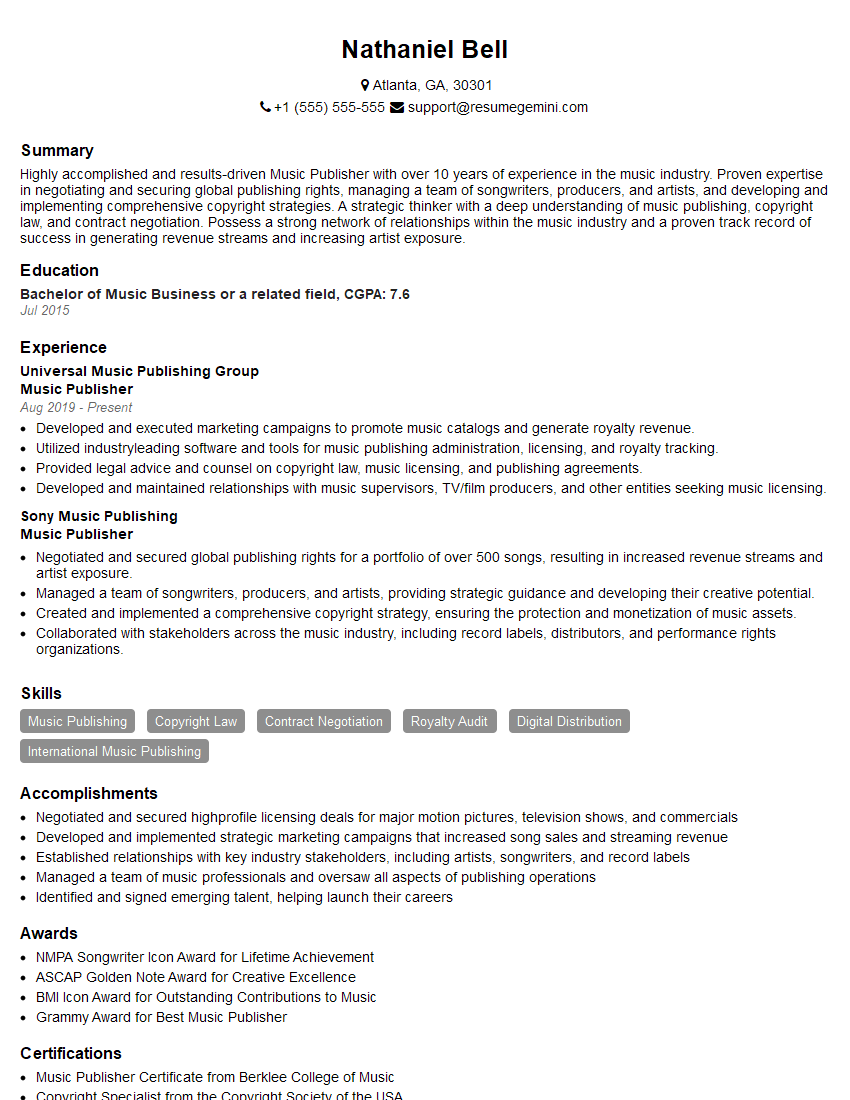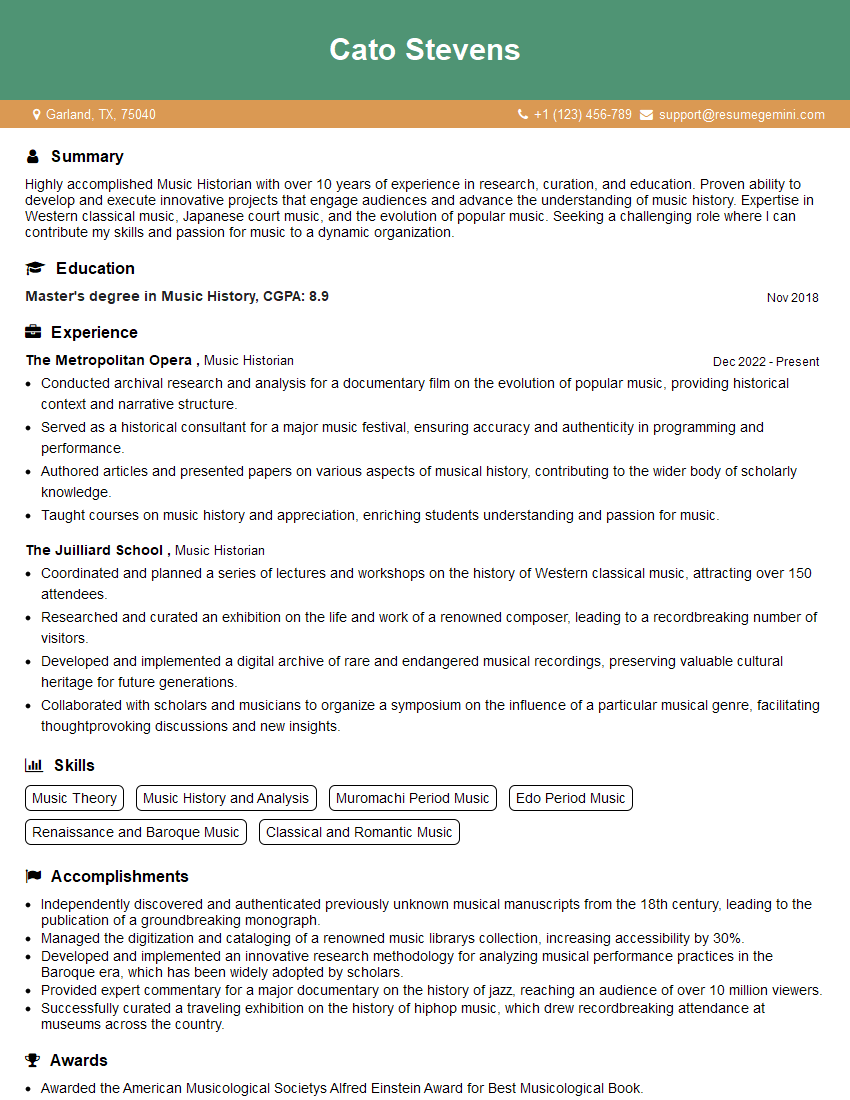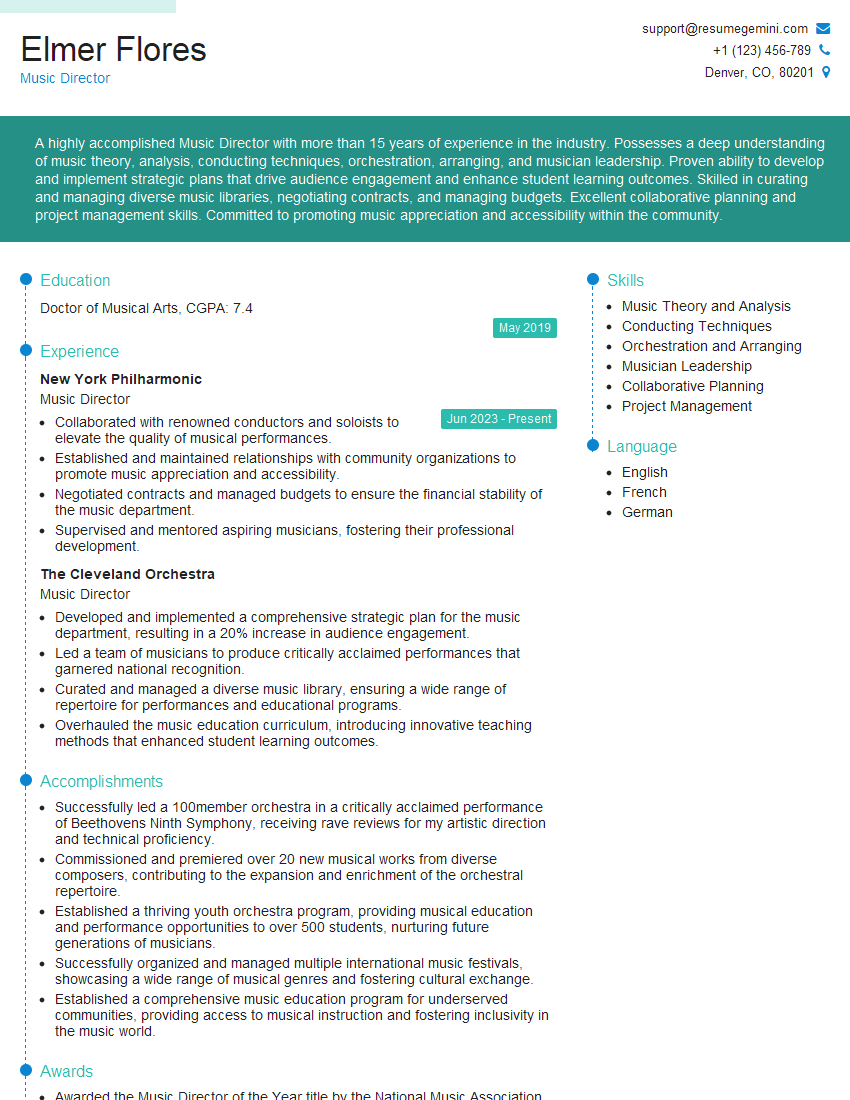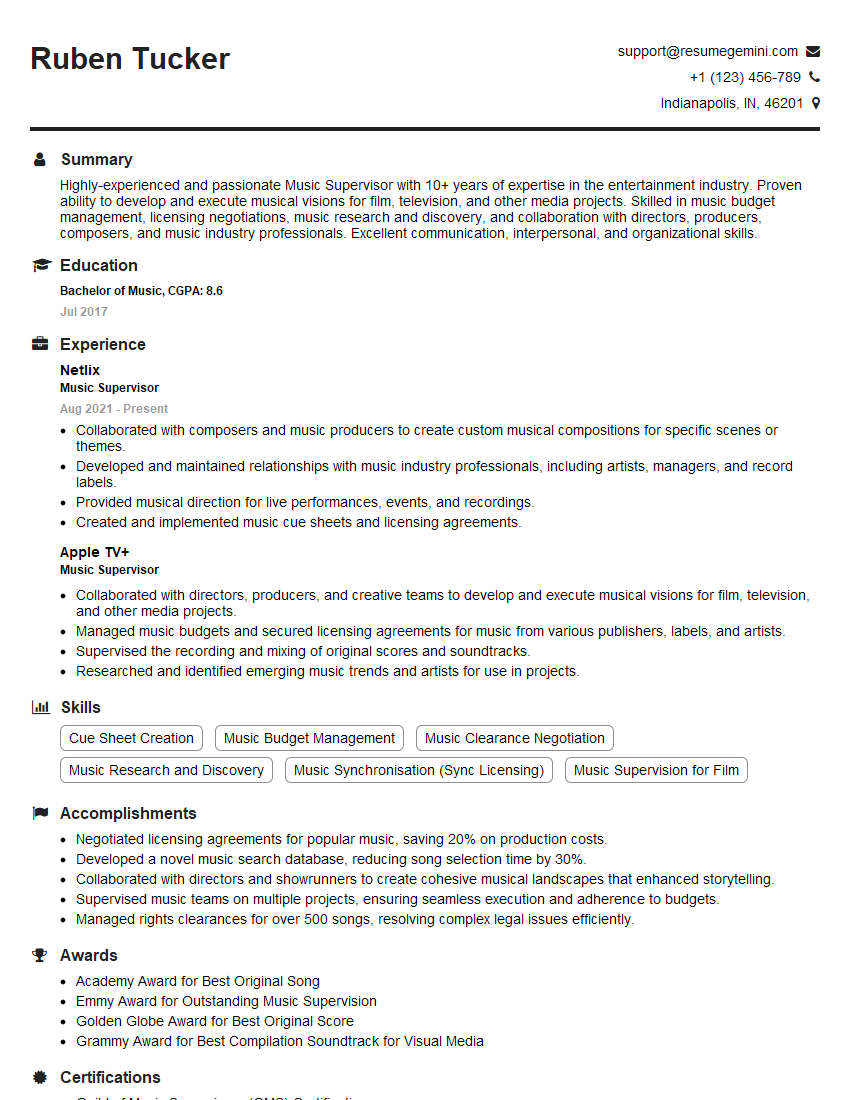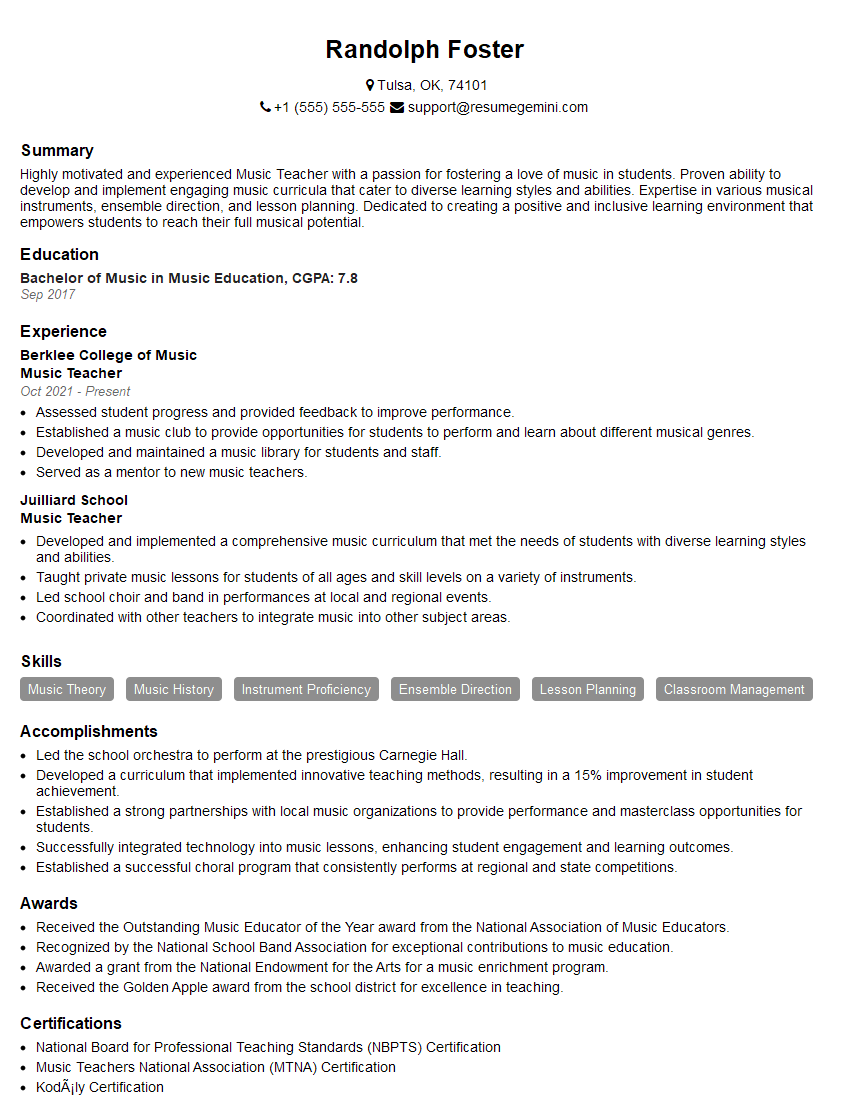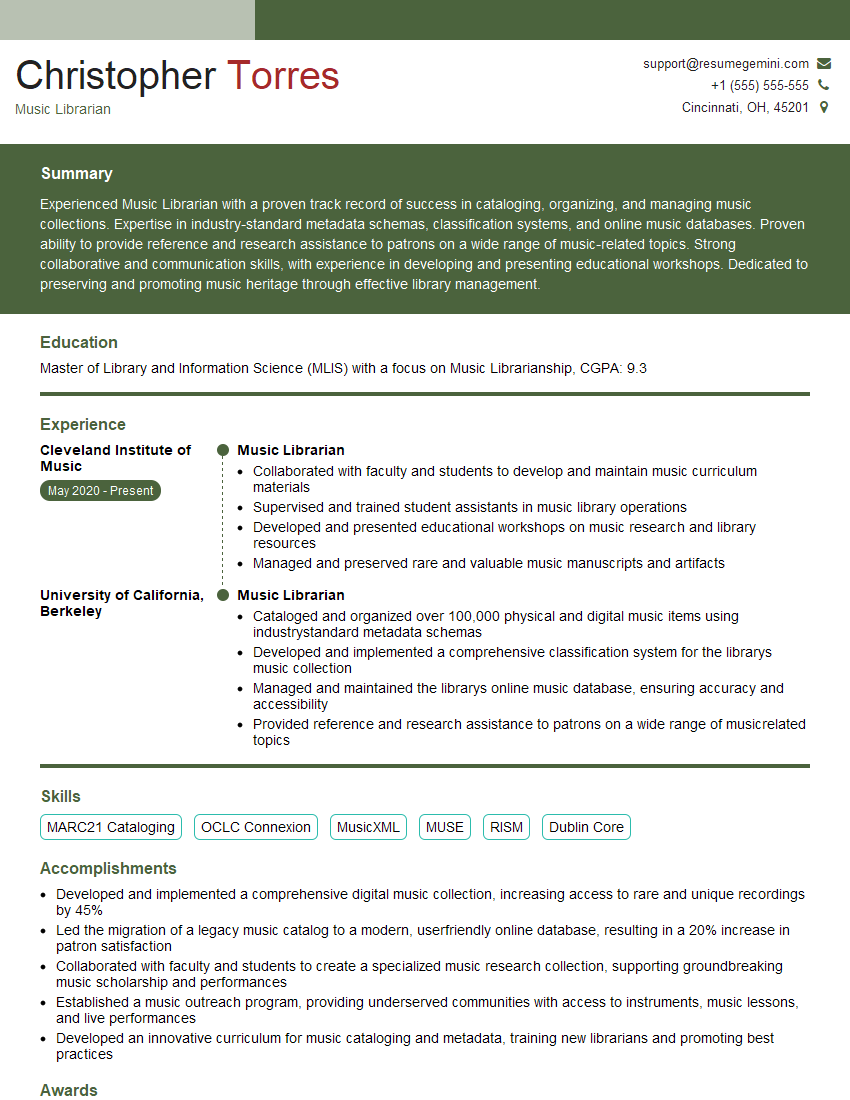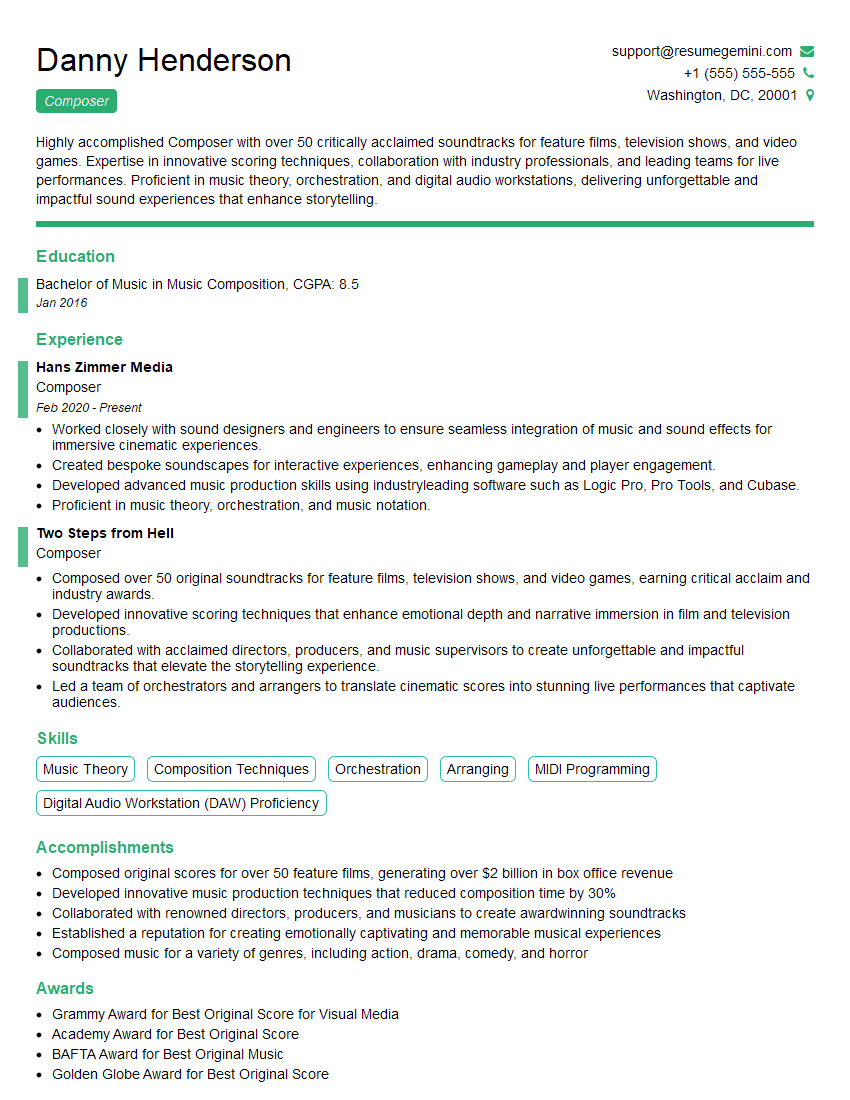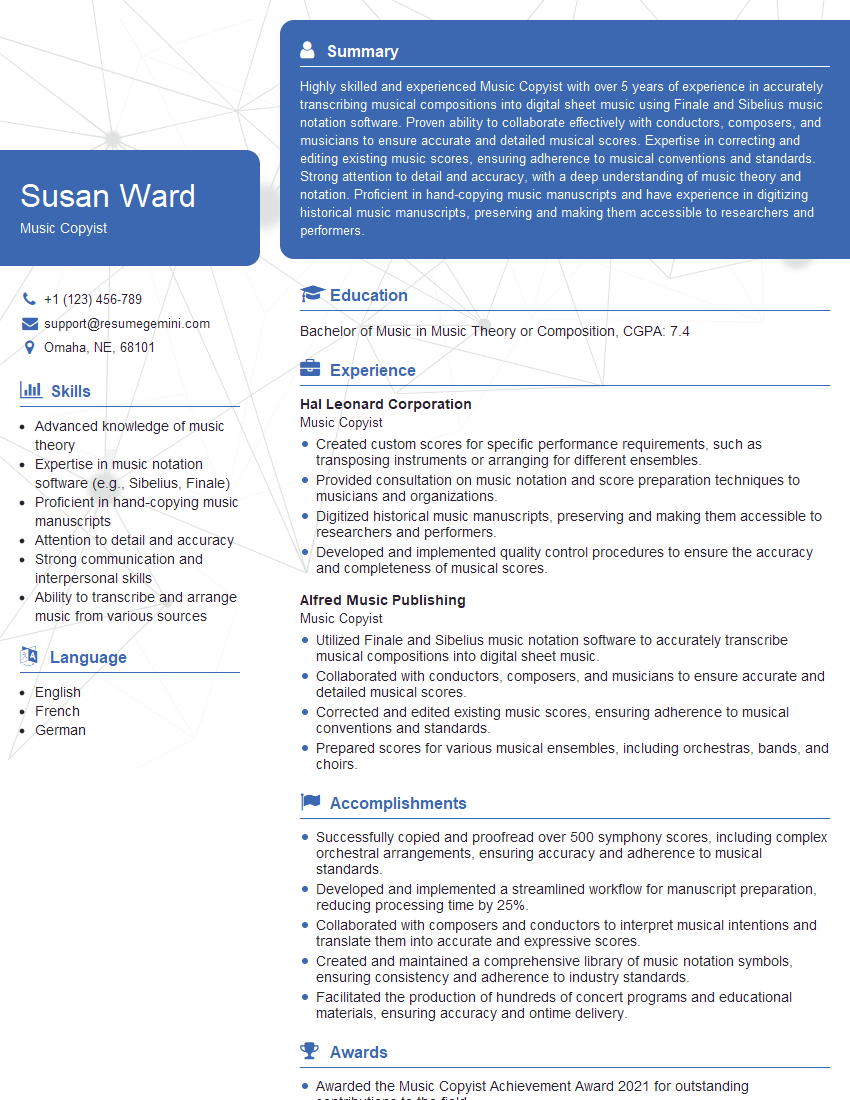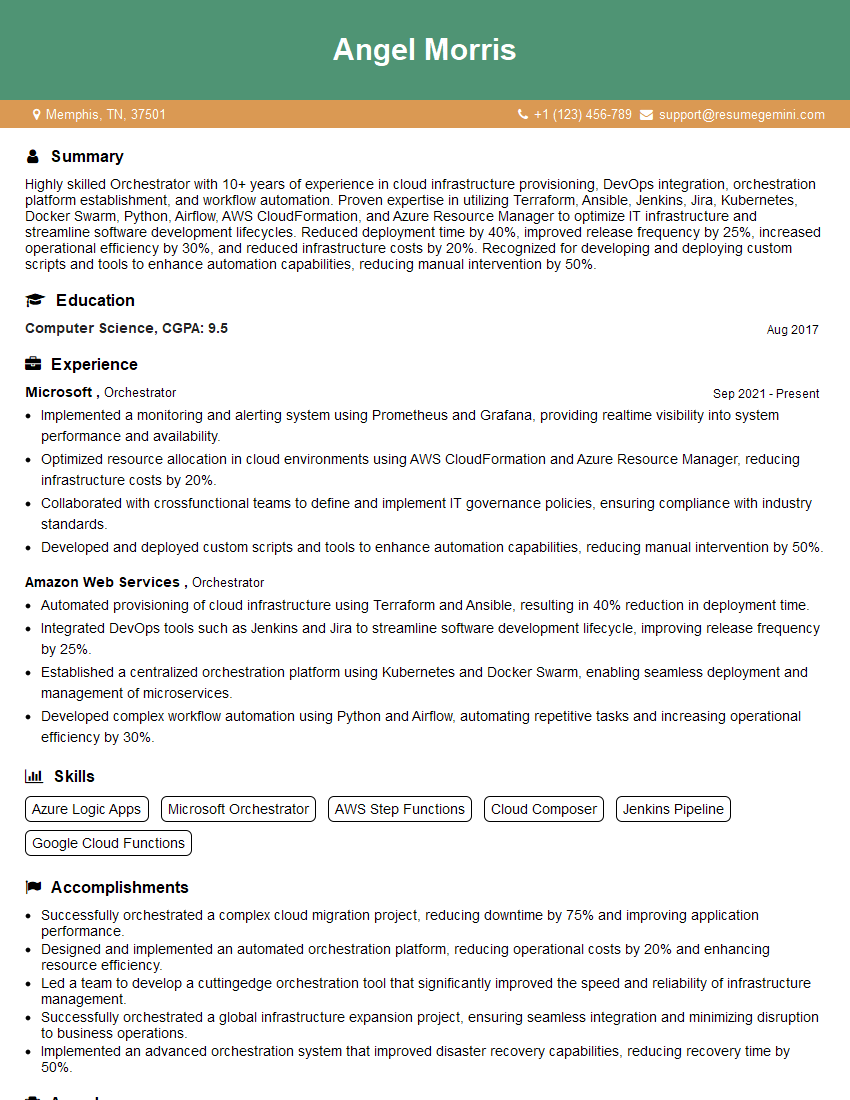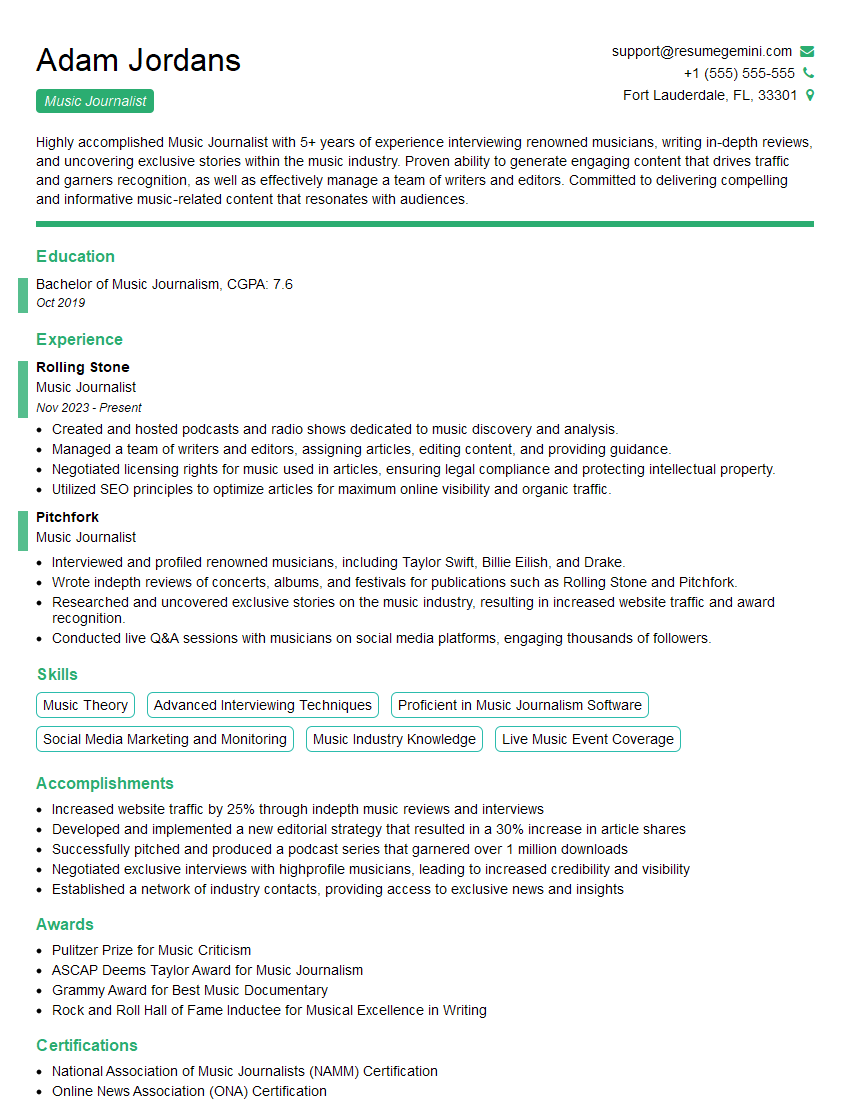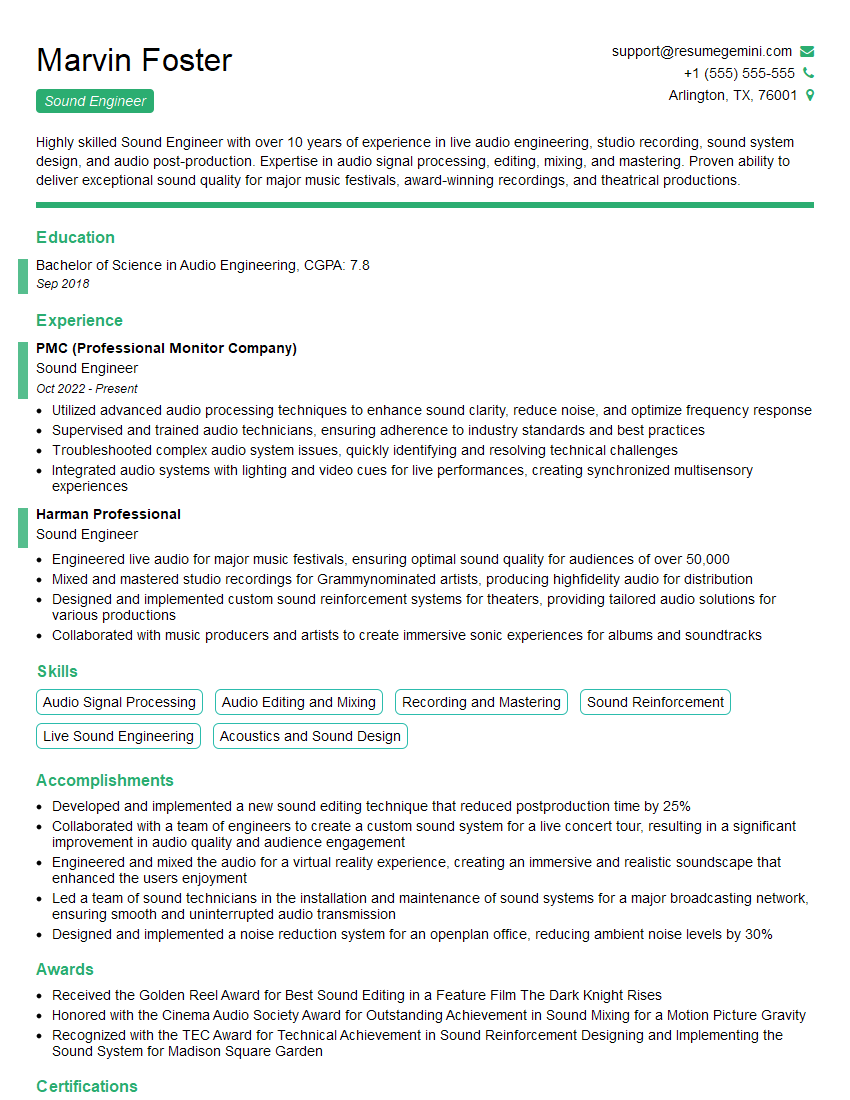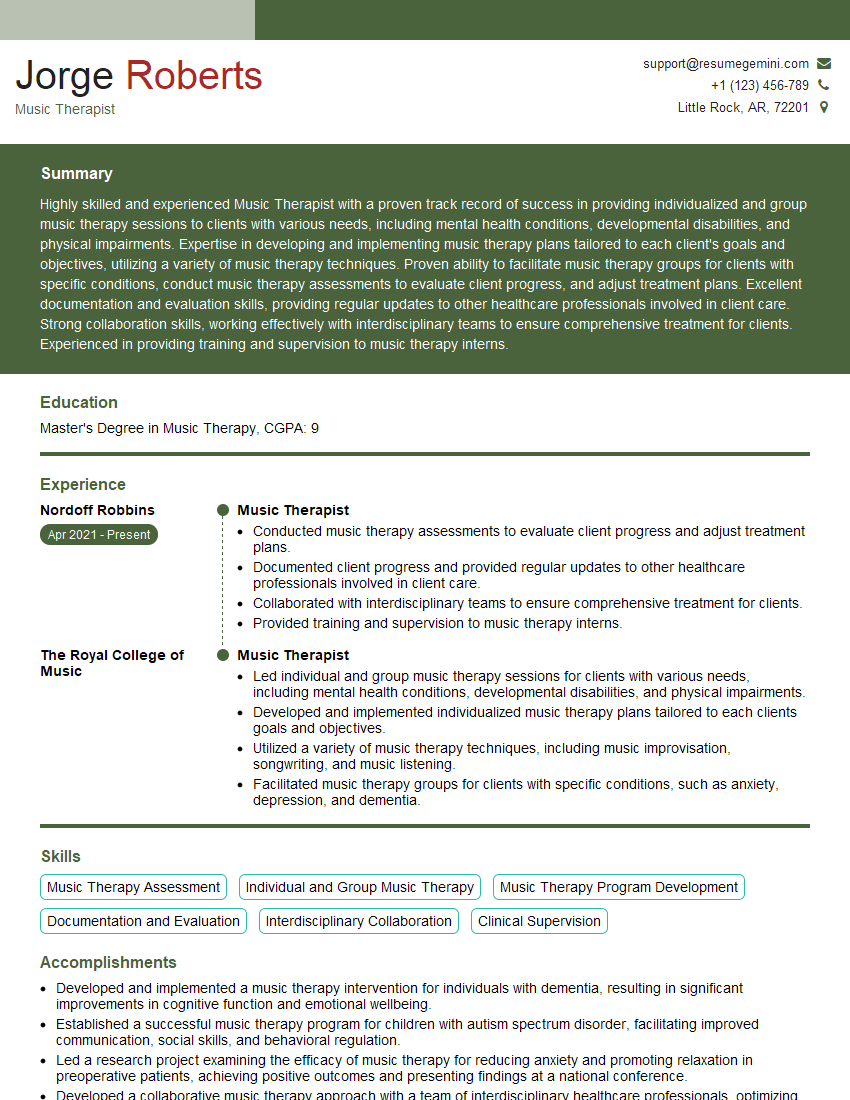Unlock your full potential by mastering the most common Music Knowledge interview questions. This blog offers a deep dive into the critical topics, ensuring you’re not only prepared to answer but to excel. With these insights, you’ll approach your interview with clarity and confidence.
Questions Asked in Music Knowledge Interview
Q 1. Explain the difference between major and minor keys.
Major and minor keys are the foundation of Western music’s tonal system, defining the overall mood and character of a piece. They differ primarily in the arrangement of their intervals – the distances between notes.
A major key sounds bright, happy, and uplifting. This is because its characteristic interval is a major third (four semitones) between the tonic (the ‘home’ note) and the third degree of the scale. For example, in C major, the interval between C and E is a major third. Major scales are built with a specific pattern of whole (two semitones) and half (one semitone) steps: W-W-H-W-W-W-H.
A minor key sounds darker, more melancholic, or serious. This is due to a minor third (three semitones) between the tonic and the third degree. In C minor, the interval between C and Eb is a minor third. Minor scales also have a characteristic pattern: W-H-W-W-H-W-W. There are three types of minor scales (natural, harmonic, and melodic), each with slightly different interval patterns, creating subtle variations in mood.
Think of it like this: major keys are like sunshine, while minor keys are like twilight. Many pieces will modulate (change keys) between major and minor to create emotional contrast and dramatic effect.
Q 2. Describe the circle of fifths.
The circle of fifths is a visual representation of the relationships between the 12 major keys (and their relative minor keys). It’s a powerful tool for composers, musicians, and music theorists alike.
Starting on any key, moving clockwise around the circle means moving up a fifth (seven semitones). Each key shares many notes and chords with its neighboring keys, making transitions between them smooth and logical. For instance, C major and G major share five notes. This interconnectedness is crucial for understanding key changes and harmonic progressions.
Here’s how it’s useful: It aids in understanding key signatures (the sharps or flats at the beginning of a piece), composing in different keys, and analyzing existing music. If you understand the circle of fifths, you can quickly identify which keys are closely related and how to smoothly transition between them. Imagine it as a map of the tonal landscape.
Q 3. What are the common time signatures in Western music?
Time signatures indicate how many beats are in each measure (bar) of music and which note value receives one beat. They are written as a fraction. The top number represents the number of beats per measure, while the bottom number indicates the type of note that gets one beat.
4/4(Common Time): Four quarter notes per measure. This is the most common time signature in Western music, often used for many genres including pop, rock, and classical.3/4(Waltz Time): Three quarter notes per measure. Characterized by its gentle, flowing rhythm, often used in waltzes and other similar dances.2/4: Two quarter notes per measure. A simple, march-like feel, often used in folk music and marches.6/8: Six eighth notes per measure, usually grouped in two sets of three. A more flowing rhythm than 4/4, often found in folk music and some classical pieces.
Other time signatures exist, but these are the most prevalent in Western musical traditions. The time signature is essential for understanding the rhythmic structure and feel of a piece of music.
Q 4. What are the basic elements of music theory?
The basic elements of music theory are the building blocks that form the structure and expression of music. They are interconnected and work together to create a complete musical experience. These include:
- Melody: A succession of musical notes that form a recognizable tune. Think of the main theme of a song.
- Harmony: The simultaneous sounding of notes, creating chords and chord progressions. It provides the underlying support to the melody.
- Rhythm: The organization of music in time, encompassing beats, measures, and patterns. It gives music its pulse and groove.
- Form: The overall structure of a musical piece. This can involve sections like verse, chorus, and bridge, or more complex structures in classical music.
- Dynamics: The loudness and softness of music. Dynamics create expression and emotion.
- Timbre (tone color): The unique quality of a sound, differentiating a violin from a trumpet, for example. It contributes to the overall texture and character of music.
Understanding these elements is fundamental to analyzing, composing, and appreciating music in all its forms.
Q 5. Explain the role of dynamics in musical composition.
Dynamics refer to the variations in loudness and softness within a musical piece. They are crucial for expression and creating emotional impact. Think of a story – a whisper creates intimacy while a shout conveys urgency.
Composers use dynamics to shape the listener’s experience, building tension, releasing it, creating contrast, and highlighting particular musical ideas. They use terms like piano (soft), forte (loud), crescendo (gradually getting louder), and decrescendo (gradually getting softer) to indicate dynamic changes. These instructions can be subtle or dramatic, shaping the emotional arc of a piece. For instance, a gradual crescendo leading to a powerful climax creates anticipation and excitement. Conversely, a sudden decrescendo can signify a moment of reflection or quietude.
Imagine listening to a dramatic orchestral work without dynamic variation – it would be monotonous and lack emotional depth. Dynamics are a fundamental element of musical expression.
Q 6. What are some common musical forms?
Musical forms refer to the overall structure and organization of a piece of music. They provide a framework for the presentation of musical ideas.
- Binary Form (AB): A two-part structure where the first section (A) is typically repeated, followed by a contrasting second section (B).
- Ternary Form (ABA): A three-part structure consisting of a first section (A), a contrasting second section (B), and a return to the first section (A). This is common in many classical pieces.
- Rondo Form (ABACA): A form characterized by a recurring theme (A) that alternates with contrasting episodes (B, C, etc.).
- Sonata Form: A complex form prevalent in classical music, typically with three sections: exposition (presenting themes), development (exploring themes), and recapitulation (restatement of themes).
- Verse-Chorus Form: A common form in popular music, featuring alternating verses (narrative sections) and choruses (repetitive, memorable sections).
Many pieces blend and modify these basic forms, creating complex and unique structures. Understanding musical forms helps to analyze and appreciate the organization and design of a musical work.
Q 7. Describe different types of musical textures.
Musical texture describes the way different musical lines or sounds interact within a piece. It refers to the density and complexity of the musical fabric.
- Monophonic: A single melodic line without accompaniment. Think of a solo singer or a single instrument playing a melody.
- Homophonic: A melody with accompanying harmony. Most popular songs and many classical pieces fall into this category. The harmony supports the melody.
- Polyphonic: Two or more independent melodic lines sounding simultaneously. This is characteristic of much of the Baroque period’s music and in fugues. Each line is equally important and contributes to the overall texture.
- Heterophonic: Simultaneous variations of a single melodic line. Different instruments or voices might play slightly different versions of the same melody at the same time.
The texture of a piece contributes significantly to its overall character and expressive potential. A thick, polyphonic texture can be powerful and complex, while a thin, monophonic texture can be delicate and intimate.
Q 8. Discuss the historical development of a specific musical genre.
Let’s trace the evolution of Blues music. Born out of the struggles of African Americans in the Deep South of the United States during the late 19th and early 20th centuries, Blues emerged from a rich tapestry of musical traditions, including African rhythms, spirituals, and work songs. It wasn’t a sudden creation but a gradual process of blending and adaptation.
Early Influences (late 1800s – early 1900s): The foundation was laid by field hollers, chants, and spirituals sung by enslaved people and later sharecroppers. These vocal expressions reflected their hardships and spiritual beliefs. The use of blue notes—slightly flattened notes that create a melancholic sound—is a defining characteristic that emerged during this period.
The Classic Blues Era (1920s – 1940s): This era saw the rise of prominent Blues musicians like Bessie Smith, Robert Johnson, and Blind Lemon Jefferson. The music became more structured, often featuring a 12-bar blues progression in a simple three-chord structure. The use of instruments like the guitar, harmonica, and piano became increasingly prevalent, adding depth and texture to the vocals.
Post-War Blues and Beyond (1940s – present): The post-war period witnessed the development of subgenres like Chicago Blues (known for its electric guitar-driven sound), Delta Blues (characterized by its raw, acoustic style), and Texas Blues (often featuring a more upbeat tempo). Blues continued to evolve, influencing genres like Rock and Roll, R&B, and even Jazz.
The history of Blues is a testament to the power of music to express human experience. From its humble beginnings in the fields to its global impact today, it remains a vital and enduring genre that reflects both the pain and resilience of its creators.
Q 9. What is your experience with music notation software?
My experience with music notation software spans over a decade, encompassing both professional and personal use. I’m proficient in Sibelius, Finale, and Dorico. I’ve used these programs extensively for composing original works, transcribing existing pieces, and preparing scores for performance. My skillset includes creating complex scores with multiple instrument parts, utilizing advanced features like engraving options, and generating various output formats (PDF, MIDI, MusicXML).
For example, I recently used Sibelius to create a full orchestral score for a contemporary ballet. The software’s capabilities for managing numerous instruments, articulations, and dynamic markings were crucial in delivering a high-quality and professional result. I’m also familiar with using notation software to create backing tracks for singers or instrumentalists.
Q 10. Explain the process of music production from start to finish.
Music production is a multifaceted process, but it typically follows these stages:
Pre-Production: This involves conceptualizing the song, writing lyrics and melodies, creating demos, and assembling the band or musicians. Sketching out the arrangement is crucial here.
Tracking: This is where individual instrumental and vocal parts are recorded. Careful microphone placement, signal routing, and monitoring are key during this phase to obtain high-quality audio recordings.
Editing: The recorded tracks are edited to remove mistakes, adjust timing, and improve overall clarity. This often involves using tools like quantization, time stretching, and pitch correction.
Mixing: This crucial step involves combining all the individual tracks, adjusting levels, EQ, compression, and other effects to achieve a balanced and cohesive mix. The goal is to create a sonic landscape where each instrument has its space yet works together harmoniously.
Mastering: The final mixed track is mastered to prepare it for distribution. This involves optimizing the overall loudness, dynamics, and frequency balance for various playback systems (CD, streaming platforms, etc.). Mastering is subtle but crucial for achieving professional-sounding audio.
Think of it like building a house. Pre-production is designing the blueprint, tracking is laying the foundation and building the structure, editing is fixing any flaws, mixing is decorating the interior, and mastering is ensuring the house is ready for its inhabitants to move in.
Q 11. Describe your experience with audio editing software.
My experience with audio editing software is extensive. I’m proficient in Pro Tools, Logic Pro X, and Ableton Live. I’ve used these DAWs (Digital Audio Workstations) to edit audio for various projects, including albums, film scores, and podcasts. My skills range from basic tasks like cutting and pasting audio to more advanced techniques such as manipulating time and pitch, noise reduction, and applying audio effects.
A recent example involved using Pro Tools to edit a podcast interview. I used its powerful editing tools to remove unwanted sounds (like coughs or background noise), adjust the levels, and apply EQ to improve clarity and improve the overall sound quality.
Q 12. What are your preferred methods for mixing and mastering audio?
My mixing and mastering techniques focus on achieving a natural and transparent sound, rather than overly processed or compressed audio. I prioritize achieving a good balance between the individual instruments and vocals in the mix. I prefer to work iteratively, continually listening and making adjustments until I achieve the desired sonic result. I use a combination of hardware and software tools, such as outboard EQs and compressors, in addition to plugins within my DAW.
For mastering, I ensure the track is optimized for various playback systems. This includes checking the overall loudness, ensuring the low-end is clear and tight, and checking for any frequency imbalances. The goal is to make the final product sound excellent on all devices, from car stereos to high-end headphones.
Q 13. Explain the concept of signal flow in audio recording.
Signal flow in audio recording refers to the path an audio signal takes from its source (e.g., microphone, instrument) to the final output (e.g., speakers, recording device). Understanding signal flow is essential for troubleshooting problems, optimizing recording quality, and creating effective audio effects.
A typical signal flow might look like this:
- Microphone or instrument
- Preamplifier (boosts the weak signal)
- Equalizer (shapes the frequency response)
- Compressor (controls the dynamic range)
- Analog-to-Digital Converter (ADC) (converts the analog signal to digital)
- Digital Audio Workstation (DAW) (processes and edits the digital audio)
- Digital-to-Analog Converter (DAC) (converts the digital signal back to analog)
- Power Amplifier (amplifies the signal)
- Speakers or headphones (output the audio signal)
Any break in this chain can cause problems, so a thorough understanding of signal flow is crucial. For example, if the gain staging (adjusting signal levels at different points) is incorrect, it can lead to clipping (distortion) or a weak signal.
Q 14. What are some common audio effects and their uses?
Many common audio effects serve distinct purposes:
Equalization (EQ): Adjusts the balance of frequencies in the audio signal. Boosting certain frequencies can enhance clarity, while cutting others can reduce muddiness. For instance, boosting high frequencies can make vocals sound brighter and cutting low frequencies can remove muddiness in a bass guitar track.
Compression: Reduces the dynamic range of an audio signal, making quiet parts louder and loud parts quieter. This can make a track sound more consistent and powerful. For example, compression is often used on vocals to make them sit better in a mix.
Reverb: Simulates the reflection of sound in a space. It can add depth, ambience, and a sense of space to a sound. For instance, adding a hall reverb to vocals can make them sound larger.
Delay: Creates echoes or repeats of the audio signal. It can add rhythmic interest, create texture, and enhance the stereo image. Delay is commonly used for creating rhythmic patterns in electronic music.
Chorus: Creates a thicker, fuller sound by layering slightly detuned copies of the original signal. It’s often used on vocals or instruments to add richness and body. Think of the lush sounds in many pop songs.
The effective use of audio effects is a crucial skill in audio engineering, enabling the creation of diverse soundscapes and enhancing the overall quality of recordings.
Q 15. How do you troubleshoot audio equipment problems?
Troubleshooting audio equipment involves a systematic approach. I start by identifying the problem: Is there no sound at all? Is there distortion? Feedback? Then, I work through a process of elimination, checking the most likely causes first.
- Power and Connections: The simplest issues often involve power cables. I check all connections – from the wall socket to the equipment and between devices. Loose or faulty cables are surprisingly common. I’ll also ensure all power switches are on.
- Signal Flow: I trace the audio signal path, step-by-step. If using a mixer, I’ll check each channel to isolate whether the issue lies with a specific input or the main output. I’ll use a known good source (like a CD player) to eliminate the source as a problem.
- Input/Output Levels: Incorrect gain staging (the balance of signal levels) is a frequent culprit. I adjust levels carefully, ensuring no clipping (excessive signal overload causing distortion) or excessively low levels. Using a VU meter or software monitoring tools helps visually.
- Equipment Specifics: For instance, if a microphone isn’t working, I’ll check the phantom power (48V) switch on the mixer if required. If a speaker is not functioning, I’ll check its impedance and ensure it’s correctly matched to the amplifier.
- Software Issues: If dealing with digital audio workstations (DAWs), I look into buffer sizes, driver issues, and conflicting software. Sometimes a simple restart can resolve these problems.
For complex issues, I’ll use diagnostic tools such as signal generators and multimeters to pinpoint faults within the components themselves. Understanding basic electronics is extremely helpful in this process. For example, I might check for continuity in a cable to detect a break.
Career Expert Tips:
- Ace those interviews! Prepare effectively by reviewing the Top 50 Most Common Interview Questions on ResumeGemini.
- Navigate your job search with confidence! Explore a wide range of Career Tips on ResumeGemini. Learn about common challenges and recommendations to overcome them.
- Craft the perfect resume! Master the Art of Resume Writing with ResumeGemini’s guide. Showcase your unique qualifications and achievements effectively.
- Don’t miss out on holiday savings! Build your dream resume with ResumeGemini’s ATS optimized templates.
Q 16. Discuss your experience with different types of microphones.
My experience encompasses a wide range of microphone types, each suited to different recording situations.
- Dynamic Microphones: These are robust, durable, and handle high sound pressure levels well, making them ideal for live sound reinforcement (e.g., Shure SM58 for vocals) and loud instruments (e.g., drum kit). They’re less sensitive to handling noise than condensers.
- Condenser Microphones: Highly sensitive, these microphones capture subtle nuances in sound, making them preferable for studio recording of vocals and acoustic instruments (e.g., Neumann U 87). They require phantom power (48V DC). Large-diaphragm condensers are known for their warmth, while small-diaphragm condensers offer excellent detail and clarity.
- Ribbon Microphones: These microphones utilize a thin metallic ribbon as a transducer, delivering a unique vintage character and often a more natural sound. They are more fragile than dynamic or condenser microphones and are prone to damage from excessive sound pressure levels.
- USB Microphones: Convenient for home recording, these microphones connect directly to a computer, eliminating the need for an audio interface. The quality varies greatly; some offer excellent sound, while others are suitable only for basic applications.
Choosing the right microphone depends on factors such as the sound source, recording environment, and desired sonic qualities. For example, a dynamic microphone might be preferred for recording a loud rock band in a live setting, whereas a condenser microphone would be more suitable for recording a delicate acoustic guitar performance in a controlled studio environment.
Q 17. What is your understanding of copyright law related to music?
Copyright law protects the intellectual property rights of musical works, encompassing the musical composition (melody, harmony, rhythm) and the sound recording (the actual performance).
- Composition Copyright: This protects the underlying musical work and grants the composer exclusive rights to reproduce, distribute, perform, and create derivative works (like arrangements or covers).
- Sound Recording Copyright: This protects the actual recorded performance and grants the recording rights holder exclusive rights to reproduce, distribute, and publicly perform the recording. This is distinct from the composition copyright.
- Mechanical Licenses: These are required to reproduce a musical composition on a physical format (e.g., CD) or a digital format (e.g., MP3 download). Performing Rights Organizations (PROs) like ASCAP, BMI, and SESAC handle these licenses.
- Synchronization Licenses: Needed to use a musical work in synchronization with visual media (e.g., film, television, advertising). These licenses typically involve a more substantial fee than mechanical licenses.
- Public Domain: Works whose copyright has expired enter the public domain, allowing anyone to use them without permission.
Understanding these nuances is crucial for musicians, composers, and anyone working with music. Failure to obtain proper licenses can result in costly infringement lawsuits. It’s always best to seek legal counsel when dealing with complex copyright issues.
Q 18. How do you approach collaboration with other musicians?
Collaboration is vital in the music industry. My approach centers on clear communication, mutual respect, and a shared artistic vision.
- Defining Roles and Responsibilities: At the outset, I clearly establish each musician’s role – songwriter, instrumentalist, producer, etc. This prevents confusion and conflict later on.
- Open Communication: I encourage open and honest feedback throughout the process. This involves active listening, constructive criticism, and a willingness to compromise. I believe in creating a safe space for creative expression.
- Respectful Differences: Different musical backgrounds and styles can enrich a project. I value and integrate diverse perspectives, fostering a collaborative spirit rather than imposing my own ideas.
- Shared Goals: A well-defined goal – be it recording an album, composing a film score, or writing a song for a specific event – provides focus and direction.
- Legal Agreements: For significant collaborations, I believe in having a written agreement outlining ownership, royalties, and other crucial aspects of the project. This safeguards everyone’s interests.
For example, in a recent collaboration, we used a shared online document to track the development of a song, allowing us to provide feedback in real time and make revisions efficiently. This transparent process fostered a positive and productive collaborative environment.
Q 19. Describe your experience with music publishing.
Music publishing involves securing copyright protection for musical works and administering the rights to those works. My experience includes understanding the various aspects of publishing, such as:
- Copyright Registration: Protecting a musical composition by registering it with the relevant copyright office (e.g., the US Copyright Office).
- Licensing Agreements: Negotiating and managing licenses for the use of musical works in various media, including recordings, films, television shows, and advertisements. This often involves working with licensing agents.
- Royalties Collection: Tracking and collecting royalties from the use of musical works. This requires careful administration and meticulous record-keeping.
- Publisher Relationships: Working with music publishers to secure the best possible deals for the songwriter and composer. This involves understanding the publishing industry landscape and negotiating favorable terms.
- Contractual Agreements: Negotiating and reviewing contracts related to publishing rights, including songwriter agreements and publishing administration deals.
I’ve worked with both independent publishers and major publishing houses, gaining a comprehensive understanding of the diverse roles and responsibilities involved in successful music publishing. The key is to ensure that the songwriter receives fair compensation for their work, while also ensuring that the work is properly protected and licensed.
Q 20. Explain your understanding of music marketing and promotion.
Music marketing and promotion are crucial for reaching audiences and building a fanbase. My approach integrates various strategies, tailored to the specific artist and their music.
- Digital Marketing: This is vital today, encompassing social media marketing (creating engaging content across platforms like Instagram, TikTok, and Facebook), targeted advertising campaigns (using platforms like Google Ads and social media ad managers), and email marketing (building an email list and sending newsletters to keep fans updated).
- Public Relations: Building relationships with media outlets, securing interviews, press releases, and reviews. This involves pitching stories and cultivating media relationships.
- Content Creation: Creating high-quality music videos, lyric videos, and behind-the-scenes content to engage fans and attract new listeners. This helps build a brand identity.
- Live Performances: Playing gigs, both large and small, to connect directly with audiences and build a fanbase. This offers a critical opportunity for audience engagement.
- Streaming Platforms: Optimizing artist profiles on Spotify, Apple Music, and other streaming services, including creating compelling artwork and playlists. This is crucial for discovery and audience reach.
A holistic approach is crucial. For example, a successful campaign might involve utilizing social media to build excitement for a new single, followed by targeted advertising to reach specific demographics. Then, building upon that engagement with a well-planned live performance and finally, securing reviews and media coverage to widen exposure further.
Q 21. Discuss your familiarity with music streaming platforms.
I’m very familiar with music streaming platforms, recognizing their significance in the contemporary music industry.
- Spotify: The largest streaming platform globally, known for its vast library, personalized playlists, and artist-focused features. Understanding its algorithms and analytics is essential for artist promotion.
- Apple Music: A major competitor with a focus on high-fidelity audio and curated playlists. It offers similar promotional features to Spotify.
- Amazon Music: Integrated with Amazon’s ecosystem, it’s a growing player in the streaming market, particularly strong in certain geographic regions.
- Tidal: Known for its high-fidelity audio offering and artist ownership model. It caters to a more niche audience.
- YouTube Music: A powerful platform particularly useful for music video promotion and discovery. The reach is considerable.
My understanding extends beyond simply using these platforms. I know how to optimize artist profiles, create compelling playlists, analyze streaming data, and leverage these platforms for marketing and promotion. For instance, understanding the role of playlist curation in driving discovery on platforms like Spotify is critical for success in today’s landscape.
Q 22. How do you stay up-to-date with current trends in the music industry?
Staying current in the dynamic music industry requires a multi-pronged approach. It’s not enough to just listen to the radio; you need a diverse intake of information.
Streaming Platforms & Charts: I regularly monitor popular streaming services like Spotify and Apple Music, paying close attention to their charts and curated playlists. This gives a good overview of trending genres and artists.
Music Blogs & Publications: I follow reputable music blogs and publications like Pitchfork, Rolling Stone, and Resident Advisor. These offer critical analyses and in-depth coverage of emerging artists and sounds.
Social Media: Platforms like TikTok, Instagram, and YouTube are crucial for discovering new artists and trends. I actively search for relevant hashtags and follow key influencers in various music scenes.
Industry Events & Conferences: Attending industry conferences and showcases (when possible) provides invaluable networking opportunities and exposes me to the latest technologies and trends firsthand.
Podcasts & Webinars: I listen to industry podcasts and attend webinars focusing on music production, marketing, and business. These offer insights into current challenges and strategies.
By combining these methods, I build a holistic understanding of current music trends, ensuring I remain relevant and informed.
Q 23. Describe a time you had to overcome a technical challenge in music production.
During the production of an album for an independent artist, we faced a significant challenge with latency issues when recording live instruments remotely. The artist was based in another state, and we were attempting to record drums and bass simultaneously over a high-speed internet connection.
The initial recordings suffered from noticeable timing discrepancies between the drums and bass, making them unusable. To overcome this, we employed several strategies:
Improved Network Infrastructure: We upgraded the internet connection at both ends, ensuring stable, low-latency bandwidth.
Advanced DAW Techniques: We used advanced features in our Digital Audio Workstation (DAW), specifically focusing on adjusting sample rates and buffer sizes to minimize latency. We also experimented with different routing techniques to reduce network load.
Detailed Communication: Constant communication with the drummer and bassist, using a combination of video conferencing and audio feedback, was vital to ensure both players were performing in sync.
Careful Editing & Quantization: Even with improved latency, some minor timing corrections were needed. We used advanced editing and quantization techniques in the DAW to ensure perfect alignment.
Ultimately, through meticulous planning, technical adjustments, and robust communication, we successfully resolved the latency issues and delivered a high-quality recording.
Q 24. How do you adapt your approach to different musical styles?
Adapting my approach to different musical styles is central to my work. It’s not just about mimicking a sound; it’s about understanding the underlying principles and emotional intent of each genre.
Genre-Specific Instrumentation: I carefully choose instruments and sounds that are characteristic of each genre. For example, using vintage synthesizers for a retro-synthwave track is vastly different from using orchestral instruments for a classical piece.
Harmonic & Rhythmic Structures: Each genre has unique harmonic and rhythmic conventions. A complex jazz arrangement will utilize sophisticated chord progressions and syncopation unlike a straightforward pop song.
Production Techniques: My production techniques are adapted to the genre. The processing and effects used on a metal track will be vastly different from those on a folk song. For example, heavy distortion and aggressive compression are often used in metal, whereas clean and natural sounds are favoured in folk music.
Emotional Considerations: The emotional impact of a piece is paramount. My approach will differ vastly whether I’m creating a dark and brooding soundscape or a bright and cheerful one.
Understanding the nuances of each genre allows me to create authentic and engaging music regardless of the style.
Q 25. Explain your experience with live sound reinforcement.
My experience in live sound reinforcement spans over several years, encompassing a variety of venues and musical styles. It’s a critical aspect of ensuring a successful live performance.
Sound System Setup & Optimization: This includes microphone selection, placement, and mixing techniques, all crucial for capturing the performance effectively. Equalization (EQ) and compression are also vital to sculpt the sound and ensure clarity.
Monitoring: I understand the importance of providing appropriate monitoring for the performers (using in-ear monitors or floor monitors) to ensure they can hear themselves and each other clearly. This is essential for consistent and accurate performance.
Troubleshooting: Quick problem-solving is crucial in live settings. I’m adept at identifying and addressing issues such as feedback, excessive noise, and equipment malfunctions.
Mixing: I can mix live performances to balance volume levels, creating a cohesive and dynamic sonic landscape for the audience.
Communication: Excellent communication with the performers, stage manager, and other technicians is key to a successful show. I am able to adapt quickly to unexpected changes and ensure smooth operation.
My experience encompasses working with both small acoustic sets and large-scale amplified concerts. I prioritize a clear, powerful, and well-balanced sound tailored to each performance’s specific requirements.
Q 26. Describe your process for creating a musical arrangement.
My process for creating a musical arrangement is iterative and collaborative, always focused on the emotional impact of the piece.
Initial Concept & Sketching: I start with a basic concept, often a melody or harmonic progression. I use a DAW to sketch out ideas, experimenting with different instrumentation and rhythmic patterns.
Structure & Form: I determine the overall structure of the arrangement, considering sections like intro, verse, chorus, bridge, etc. This involves crafting a compelling narrative flow.
Instrumentation & Arrangement Details: I select instruments appropriate for the style and mood, and then meticulously arrange each part, paying close attention to voicing, counterpoint, and dynamics.
Production & Mixing: After the arrangement is complete, I move into production, focusing on sound design, effects processing, and mixing. This stage aims to refine and enhance the overall sound.
Refinement & Collaboration: I continuously refine the arrangement based on feedback, listening tests, and further experimentation. Collaboration with other musicians and producers is essential throughout this process.
The process is fluid and dynamic; I embrace experimentation and allow for unexpected developments to shape the final arrangement.
Q 27. How would you approach composing music for a specific film or video game?
Composing for film or video games requires a deep understanding of storytelling and visual media. It’s about creating a sonic landscape that enhances the emotional impact of the visuals.
Script & Visual Analysis: I carefully analyze the script and visual elements, identifying key emotional moments and thematic elements. This is the foundation of the musical score.
Mood & Tone: I determine the appropriate mood and tone for each scene, using musical elements like tempo, harmony, and instrumentation to reflect the on-screen action and emotions.
Thematic Development: I create musical themes to represent key characters, locations, or ideas, developing and transforming them throughout the score to create coherence and emotional depth.
Collaboration with Director/Game Designer: Close communication with the director or game designer is crucial to ensure the music aligns with their vision. Feedback and iterative revisions are essential.
Sound Design & Mixing: Appropriate sound design and mixing techniques are employed to create a cohesive and powerful soundscape, ensuring the score integrates seamlessly with the visual medium.
Ultimately, the goal is to create music that is both aesthetically pleasing and functionally effective, seamlessly enhancing the viewer’s or player’s experience.
Q 28. What is your understanding of music therapy techniques?
Music therapy uses music interventions to achieve therapeutic goals. My understanding encompasses several key approaches:
Active Music Making: This involves actively engaging patients in music-making activities like playing instruments, singing, or songwriting, to improve their physical, cognitive, or emotional state.
Receptive Music Listening: This utilizes the power of music listening to evoke emotions, reduce anxiety, or improve mood, tailoring the music selections to meet the patient’s specific needs and preferences.
Music-Assisted Relaxation Techniques: This approach combines music with other relaxation strategies, such as guided imagery or deep breathing, to achieve deeper relaxation and stress reduction.
Improvisational Music Therapy: This technique encourages spontaneous musical expression, allowing patients to explore their emotions and experiences through music improvisation.
Neurological Music Therapy: This focuses on applying music to improve cognitive functions or motor skills in patients with neurological conditions like stroke or Parkinson’s disease.
It’s crucial to note that music therapy is a specialized field requiring professional training and certification. My knowledge is based on my research and study of the field and not on professional practice.
Key Topics to Learn for Your Music Knowledge Interview
Ace your upcoming interview by focusing on these core areas of music knowledge. Remember, depth of understanding is key, not just breadth!
- Music Theory Fundamentals: Mastering scales, chords, intervals, and key signatures is crucial. Consider how these elements create musical texture and emotion.
- Musical Forms and Structures: Understand common musical forms (sonata form, rondo, etc.) and how composers utilize structure to build musical narratives. Practice analyzing scores to identify these structures.
- History of Music: Develop a strong understanding of major periods and movements in music history, including key composers and their stylistic contributions. Be prepared to discuss the evolution of musical styles and their influences.
- Genres and Styles: Demonstrate familiarity with diverse musical genres and styles, understanding their defining characteristics and historical contexts. Be able to discuss the evolution and interrelationships of different genres.
- Aural Skills: Sharpen your ability to identify intervals, chords, melodies, and rhythms by ear. Practice dictation and transcription exercises to strengthen this essential skill.
- Instrumentation and Orchestration: Develop a strong understanding of different instruments and their roles within an ensemble. Be able to discuss the principles of orchestration and how composers use instrumentation to create specific effects.
- Analysis and Interpretation: Practice analyzing musical works, focusing on identifying formal structures, harmonic progressions, melodic contours, and rhythmic patterns. Discuss your interpretations of musical pieces and the underlying emotional impact.
Next Steps: Elevate Your Career with a Powerful Resume
Mastering music knowledge opens doors to exciting career opportunities. To make the most of your preparation, focus on creating a resume that highlights your skills and experience effectively. An ATS-friendly resume is crucial for getting your application noticed by recruiters.
We recommend using ResumeGemini to build a professional and impactful resume. ResumeGemini offers a user-friendly interface and provides examples of resumes tailored to Music Knowledge roles, ensuring your application stands out from the competition. Take the next step towards your dream career today!
Explore more articles
Users Rating of Our Blogs
Share Your Experience
We value your feedback! Please rate our content and share your thoughts (optional).
What Readers Say About Our Blog
Hello,
We found issues with your domain’s email setup that may be sending your messages to spam or blocking them completely. InboxShield Mini shows you how to fix it in minutes — no tech skills required.
Scan your domain now for details: https://inboxshield-mini.com/
— Adam @ InboxShield Mini
Reply STOP to unsubscribe
Hi, are you owner of interviewgemini.com? What if I told you I could help you find extra time in your schedule, reconnect with leads you didn’t even realize you missed, and bring in more “I want to work with you” conversations, without increasing your ad spend or hiring a full-time employee?
All with a flexible, budget-friendly service that could easily pay for itself. Sounds good?
Would it be nice to jump on a quick 10-minute call so I can show you exactly how we make this work?
Best,
Hapei
Marketing Director
Hey, I know you’re the owner of interviewgemini.com. I’ll be quick.
Fundraising for your business is tough and time-consuming. We make it easier by guaranteeing two private investor meetings each month, for six months. No demos, no pitch events – just direct introductions to active investors matched to your startup.
If youR17;re raising, this could help you build real momentum. Want me to send more info?
Hi, I represent an SEO company that specialises in getting you AI citations and higher rankings on Google. I’d like to offer you a 100% free SEO audit for your website. Would you be interested?
Hi, I represent an SEO company that specialises in getting you AI citations and higher rankings on Google. I’d like to offer you a 100% free SEO audit for your website. Would you be interested?
good
